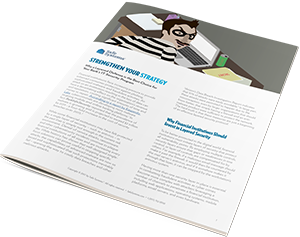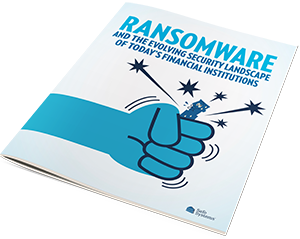What Community Banks and Credit Unions Should Budget for in 2018

Many financial institutions are entering (or are already within) their 2018 budget season. While creating a budget is essential in helping you execute your strategy and plan for the future, any shortcomings, such as the ability to respond to changes in regulation or things you didn’t adequately plan for, can quickly derail your plans and force you to make critical trade-offs. As community banks and credit unions dive into this process, it is important to evaluate all areas and think outside the box on key IT, security and compliance budget items that are often overlooked. Since we work with more than 600 financial institutions just like yours, we are constantly researching what’s coming next, both from technology and compliance viewpoints and offer some points for consideration in your budgeting for 2018.
2017 started with several ransomware incidents and culminated mid-year with one of the largest breaches ever – directly impacting more than half of the adults in the United States– with the Equifax breach. Expect “Cybersecurity” and “Information Security” to be buzz words going forward for the next few years. No business wants to have a breach and no regulatory agency wants to sign off on a business’ processes only to have them be breached. Look for the regulatory agencies to start looking out for number one by putting pressure on you, the financial institution, to step up your cybersecurity efforts.
Per some studies, up to 90% of cybersecurity spending is directed towards securing the network, yet 72% of all breaches happen from the application level. This disconnect indicates that, while the money spent may prove effective on stopping perimeter exposure, it has likely left an unexpected weakness in overall protection.
Expect cybersecurity and added layers to be a focus over the next few years. The layers are often moving from the perimeter to the device level. Considering most breaches go unnoticed for 100-200 days, expect an emphasis on forensics and monitoring in the coming year(s) as well.
As you are setting budgets for 2018, here are some key line items for consideration:
- Malware/Ransomware Layers: $1,500 – $5,000
Remember that 2016 and early 2017 were very heavy in malware, especially ransomware. While this seemed to cool off toward the end of 2017, experts expect this to be a major issue for the foreseeable future. The price will depend on the layers you select and how many you choose to add. You should really consider taking a more aggressive step in your fight against malware this year. If 2016 and 2017 taught us anything, it is that malware, and specifically ransomware, is back with a vengeance. More legitimate websites are unknowingly infected with malware and more emails are getting through with malware than in years past.
Malware has also evolved into a more aggressive threat. It’s no longer characterized by simple aggravating popups and sluggish computers, but is now encrypting all of the data on your machine, rendering it unusable. It’s gathering credentials of users, or even sometimes gathering documents and information on the machines themselves. Safe Systems has had more calls from both customers and non-customers about aggressive malware in 2016 than in years past and that trend looks to continue.
Financial institutions should evaluate their current layers, their effectiveness, and what they can do to enhance their cybersecurity posture. This may mean more/different end user training, DNS Filtering, or actual implementation of anti-ransomware toolsets. Whatever course you choose, know that the battle to protect your data is real, and it is as important as ever.
- Cybersecurity Policy and Incident Response Testing: $4,000 – $7,500
Cybersecurity preparedness does not start or end with the Cybersecurity Assessment Tool (CAT), but it does play a role. Examiners will be looking at this for at least acknowledgement that you understand cybersecurity is a real issue and you are working on addressing it. We still speak with institutions who have done little to nothing with the CAT. With the current risk environment constantly escalating, regulators are unlikely to continue to let this slide.
- Honey Pots: $2,500+
A security professional at a major security conference earlier this year referenced baiting and monitoring for criminal activity as one of the most effective measures to know if you have been compromised. Often referred to as “honey pots,” this refers to decoys set up to look interesting to anyone “snooping” around. With a solid solution in place, your institution could know of an intruder within minutes instead of the estimated 100-200 days noted above. If Target or Equifax had used similar solutions, they would likely have not been compromised or damaged to the extent that they were.
- Robust Vendor Management Solution: $2,500 – $5,000
With financial institutions delivering more products via third-party vendors than ever before, regulators are looking for a thorough vendor management program that ensures that all vendors are being reviewed regularly. For the average community bank, the process to properly perform vendor due diligence and vendor management has become too cumbersome. An automated solution provides a more efficient, cost effective way to address this. This also ties into the cybersecurity preparedness. As data has moved outside the institution, it’s more important than ever to make sure your vendors are keeping your data safe.
- New and Replacement Technology: $500 – $10,000
 Be sure that all products your vendors are “sun setting” are budgeted to be updated or replaced. Also, ensure that key applications and settings are updated to the latest best practices, including:
Be sure that all products your vendors are “sun setting” are budgeted to be updated or replaced. Also, ensure that key applications and settings are updated to the latest best practices, including:- Expired in 2017 and should be replaced or upgraded
- Windows Vista
- Symantec Endpoint 10.x
- Microsoft Office and Exchange 2007
- Backup Exec 2015
- Adobe Acrobat XI
- Expires in 2018 and should be replaced or upgraded
- ESXi/vCenter 5.5 expires 9/19/2018
- Training: $500 – $1,500
Information security is an issue that not only affects your institution, its employees and Board of Directors, but also extends to your customers. In fact, FFIEC guidelines now expect you to enhance the training programs you may already have in place. This is an area where many institutions could make a lot of improvement for the fewest dollars. Employees, via intent or mistake, are often the starting points for the breaches many institutions face. A single employee has been blamed for much of what happened in the Equifax breach. Make sure your employees and customers have access to the appropriate training commiserate with their needs. Information security knowledge and understanding affects all employees at some level, so ensure that your budget includes the appropriate training for each type of employee.
- Vendor and User Conferences: $1,000 – $1,800
It is important to stay up to date with the latest features and industry changes. An effective way to achieve this is to attend a vendor conference or user group event. Make sure to budget for key vendor conferences as an educational and vendor management function.
Strengthen Your Strategy: Why a Layered Defense is the Best Choice for Your Bank’s IT Security Program
Learn why a single layer of security, such as antivirus, is no longer enough in the current risk environment.

Some careful forethought in the budgeting process today can prevent you from having to make difficult decisions and trade-offs next year. With more than 20 years of service in the financial industry, working with more than 600 institutions, and actively managing 20,000+ devices, Safe Systems has gained a unique perspective on what is important to financial institutions and to the regulators that oversee them. We encourage you to leverage our expertise as you develop your strategic plans and budgets for the coming year.




